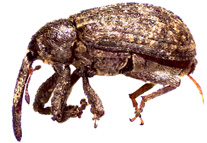Abstract
Four new species of the previously monotypic genus Narberdia Burke are described. All of them are intimately associated with plants of the genus Bernardia (Euphorbiaceae). Narberdia cervantae Soto-Hernández, new species (México, Jalisco on Bernardia spongiosa McVaugh), N. sarukhani Soto-Hernández, new species (México, Veracruz and Costa Rica on B. mexicana (Hook. & Arn.) Müll. Arg. and B. nicaraguensis Standl. & L.O. Williams), N. dugesi Soto-Hernández (México, Querétaro and Michoacán on B. mexicana and B. albida Lundell), and N. ramuvei Soto-Hernández, new species (México, Durango, Jalisco and Puebla on B. changii A. Cerv. & Flores Olv., B. rzedowskii A. Cerv. & Flores Olv. and B. valdesii A. Cerv. & Flores Olv.). Use of more than one species of plant as a host by one species of weevil is a common occurrence in Anthonomini. Sexual dimorphism is evident in the species with the female rostrum more slender and relatively longer than in male, the antennal scape attached near the midpoint of the rostrum in the female and beyond the midpoint in the male, and female with pro- and mesotibia bearing a tooth adjacent to the mucro, this tooth absent in the male. Specimens were collected at elevations from 62 m to 2288 m. The genus, previously only known from the United States of America and extreme northern México is now also known from Costa Rica as well as other areas of México. Narberdia apparently is most closely related to several Anthonomus squamosus species group members, both with similar characters of the body and form of the male median lobe (broad at the apex and strongly narrowed near the apex).
References
Alonso-Zarazaga, M.A. & Lyal, C.H.C. (1999) A world catalogue of families and genera of Curculionoidea (Excepting Scolytidae and Platypodidae). EntomoPraxis S.C.P., Barcelona, 316 pp.
Anderson, R.S. (1993) Weevils and plants: Phylogenetic versus ecological mediation of evolution of host plant associations in Curculioninae (Coleoptera: Curculionidae). Memoirs of the Entomological Society of Canada, 165, 197–232.
https://doi.org/10.4039/entm125165197-1Anderson, R.S. (2002) Family 131. Curculionidae Latreille 1802. In: Arnett, R.H. Jr., Thomas, M.C., Skelley P.E. & Frank, H.J. (Eds.), American Beetles. Vol. II. Polyphaga: Scarabaeoidea through Curculionoidea. CRC Press, Boca Raton, pp. 722–806.
Burke, H.R. (1976) Bionomics of the Anthonomine weevils. Annual Review of Entomology, 21, 283–303.
https://doi.org/10.1146/annurev.en.21.010176.001435Burke, H.R. & Rector, B.S. (1976) A new Anthonomine genus and species from Texas and México, with larval and pupal descriptions and biological notes (Coleoptera: Curculionidae). Journal of the Kansas Entomological Society, 49 (4), 541–550.
Cervantes, M.A.A. (2006) Sistemática de Bernardia sección Tyria (Euphorbiaceae). Tesis de Doctorado, Instituto de Biología, Universidad Nacional Autónoma de México (UNAM), México City, 176 pp.
Cervantes, A. & Flores, O.H. (2005) Six New Mexican species of Bernardia (Euphorbiaceae). Botanical Journal of the Linnean Society, 149, 241–256.
https://doi.org/10.1111/j.1095-8339.2005.00435.xClark, W.E. (1987) The Species of Anthonomus in the Albolineatus Group (Coleoptera: Curculionidae). Transactions of the American Entomological Society, 113 (4), 309–359.
Clark, W.E. (1993) The Anthonomus ocularis Species Group (Coleoptera: Curculionidae). Transactions of the American Entomological Society, 119 (2), 95–130.
Clark, W.E. & Burke, H.R. (1986) Phylogeny of the species of the Anthonomus subgenus Anthonomorphus Dietz, with discussion of relationships with Anthonomus grandis Boheman (Coleoptera: Curculionidae). Journal of the Kansas Entomological Society, 59 (3), 508–516.
Clark, W.E. & Burke, H.R. (1996) The Species of Anthonomus Germar (Coleoptera: Curculionidae) associated with plants in the family Solanaceae. Southwestern Entomological Society, 19 (Supplement), 1–114.
Franz, N.M. (2004) Analysing the history of the derelomine flower weevil–Carludovica association (Coleoptera: Curculionidae; Cyclanthaceae) Biological Journal of the Linnean Society, 81, 483–517.
https://doi.org/10.1111/j.1095-8312.2003.00293.xGovaerts, R., Frodin, D.G. & Radcliffe-Smith, A. (2011) World Checklist and Bibliography of Euphorbiaceae (and Pandaceae). The Board of Trustees of the Royal Botanic Gardens. Available from: http://apps.kew.org/wcsp/acceptedRef.do?name_id=20736 (accessed 9 February 2017)
O’Brien, C.W. & Wibmer, G.J. (1982) Annotated checklist of the weevils (Curculionidae sensu lato) of North America, Central America, and the West Indies (Coleoptera: Curculionidae). Memoirs of the American Entomological Institute, 34, i–ix + 1–563.
Soto-Hernández, M., Jones, R.W. & Reyes-Castillo, P. (2013) A key to the Mexican and Central American genera of Anthonomini (Curculionidae, Curculioninae). Zookeys, 260, 31–47.
https://doi.org/10.3897/zookeys.260.3989Webster, G.L. (1994) Synopsis of the genera and suprageneric taxa of Euphorbiaceae. Annals of the Missouri Botanical Garden, 81, 33–144.
https://doi.org/10.2307/2399909

